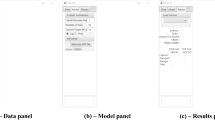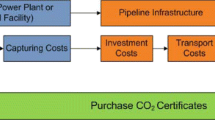Abstract
CO2 capture and storage (CCS) is a climate change mitigation strategy that aims to reduce the amount of CO2 vented into the atmosphere from industrial processes. Designing cost-effective CCS infrastructure is critical in meeting CO2 emission reduction targets and is a computationally challenging problem. We formalize the computational problem of designing cost-effective CCS infrastructure and detail the fundamental intractability of designing CCS infrastructure as problem instances grow in size. We explore the problem’s relationship to the ecosystem of network design problems, and introduce three novel algorithms for its solution. We evaluate our proposed algorithms against existing exact approaches for CCS infrastructure design and find that they all run in dramatically less time than the exact approaches and generate solutions that are very close to optimal. Decreasing the time it takes to determine CCS infrastructure designs will support national-level scenario analysis, undertaking risk and sensitivity assessments, and understanding the impact of government policies (e.g., tax credits for CCS).








Similar content being viewed by others
Notes
Enhanced oil recovery is the process of injecting CO2 into oil fields to increase production. Oil fields will pay for CO2 for this purpose, so the capture facility will collect proceeds from sale of CO2 to the oil field.
References
Altiparmak F, Karaoglan I (2008) An adaptive Tabu-simulated annealing for concave cost transportation problems. J Oper Res Soc 59:331–341
Bazlamacci CF, Hindi KS (1996) Enhanced adjacent extreme-point search and Tabu search for the minimum concave-cost uncapacitated transshipment problem. J Oper Res Soc 47:1150–1165
Billheimer JW, Gray P (1973) Network design with fixed and variable cost elements. Transp Sci 7(1):49–74
Costa AM (2005) A survey on benders decomposition applied to fixed-charge network design problems. Comput Oper Res 32(6):1429–1450
Crainic TG, Gendron B, Hernu G (2005) A slope scaling/lagrangean perturbation heuristic with long-term memory for multicommodity capacitated fixed-charge network design. J Heuristics 10:525–545
Dang C, Sun Y, Wang Y, Yang Y (2011) A deterministic annealing algorithm for the minimum concave cost network flow problem. Neural networks? Off J Int Neural Netw Soc 24:699–708
Ekiolu B, Ekiolu SD, Pardalos PM (1970) Solving large scale fixed charge network flow problems. In: Equilibrium problems and variational models, pp 163–183
Fontes DB, Gonalves JF (2007) Heuristic solutions for general concave minimum cost network flow problems. Networks 50:67–76
Fontes DB, Gonalves JF (2012) Solving concave network flow problems. FEP working papers 475
Gale J, Christensen NP, Cutler A, Torp TA (2001) Demonstrating the Potential for Geological Storage of CO\(_2\)?: The Sleipner and GESTCO projects. Environ Geosci 8(3):160–165
Gallo G, Sandi C, Sodini C (1980) An algorithm for the min concave cost flow problem. Eur J Oper Res 4:248–255
Gendron B (2011) Decomposition methods for network design. Proc Soc Behav Sci 20:31–37
Gendron B, Larose M (2014) Branch-and-price-and-cut for large-scale multicommodity capacitated fixed-charge network design. EURO J Comput Optim 2(1–2):55–75
Gendron B, Hanafib S, Todosijevib R (2018) Matheuristics based on iterative linear programming and slope scaling for multicommodity capacitated fixed charge network design. Eur J Oper Res 268:78–81
Glover F (2005) Parametric ghost image processes for fixed-charge problems: a study of transportation networks. J Heuristics 11:307–336
Guisewite G, Pardalos P (1990) Minimum concave-cost network flow problems: applications, complexity, and algorithms. Ann Oper Res 25:75–99
Guisewite GM, Pardalos PM (1991) Algorithms for the single-source uncapacitated minimum concave-cost network flow problem. J Global Optim 1:245–265
Hochbaum DS, Segev A (1989) Analysis of a flow problem with fixed charges. Networks 19(3):291–312
Hoover B, Yaw S, Middleton R (2020) Costmap: an open-source software package for developing cost surfaces using a multi-scale search kernel. Int J Geogr Inf Sci 34(3):520–538
Khang DB, Fujiwara O (1991) Approximate solutions of capacitated fixed-charge minimum cost network flow problems. Networks 21:47–58
Kim D, Pardalos PM (1999) A solution approach to the fixed charge network flow problem using a dynamic slope scaling procedure. Oper Res Lett 24(4):195–203
Kim D, Pan X, Pardalos PM (2006) Enhanced adjacent extreme-point search and Tabu search for the minimum concave-cost uncapacitated transshipment problem. Comput Econ 27:273–293
Kliewer G, Timajev L (2005) Relax-and-cut for capacitated network design. Eur Symp Algorithms 3669:47–58
Kowalski K, Lev B, Shen W, Tu Y (2014) A fast and simple branching algorithm for solving small scale fixed-charge transportation problem. Oper Res Perspect 1:1–5
Lamar BW, Sheffi Y, Powell WB (1990) A capacity improvement lower bound for fixed charge network design problems. Oper Res 38(4):704–710
Middleton RS (2013) A new optimization approach to energy network modeling: anthropogenic CO\(_2\) capture coupled with enhanced oil recovery. Int J Energy Res 37(14):1794–1810
Middleton RS, Bielicki JM (2009) A scalable infrastructure model for carbon capture and storage: SimCCS. Energy Policy 37(3):1052–1060
Middleton RS, Kuby MJ, Bielicki JM (2012) Generating candidate networks for optimization: the CO\(_2\) capture and storage optimization problem. Comput Environ Urban Syst 36(1):18–29
Middleton RS, Yaw SP, Hoover BA, Ellett KM (2020) SimCCS: an open-source tool for optimizing CO\(_2\) capture, transport, and storage infrastructure. Environ Model Softw 124:104560
Monteiro MSR, Fontes DBMM (2005) Locating and sizing bank-branches by opening, closing or maintaining facilities. Oper Res Proc 2005:303–308
Morbee J, Serpa J, Tzimas E (2011) Optimal planning of CO\(_2\) transmission infrastructure: the JRC InfraCCS tool. In: 10th international conference on greenhouse gas control technologies. Energy Procedia 4:2772 – 2777
National Energy Technology Laboratory (2018) FE/NETL CO\(_2\) transport cost model. https://www.netl.doe.gov/research/energy-analysis/searchpublications/vuedetails?id=543
National Petroleum Council (2019) Meeting the dual challenge: a roadmap to at-scale deployment of carbon capture, use, and storage
Ortega F, Wolsey LA (2003) A branch-and-cut algorithm for the single-commodity, uncapacitated, fixed-charge network flow problem. Networks 41(3):143–158
Poorzahedy H, Rouhani O (2007) Hybrid meta-heuristic algorithms for solving network design problem. Eur J Oper Res 182:578–596
Raz R, Safra S (1997) A sub-constant error-probability low-degree test, and a sub-constant error-probability PCP characterization of NP. In: ACM STOC
Smit B (2014) Computational carbon capture. In: ACM e-Energy 2014 keynote
Smith DK, Walters GA (2000) An evolutionary approach for finding optimal trees in undirected networks. Eur J Oper Res 102:593–602
van den Broek M, Brederode E, Ramrez A, Kramers L, van der Kuip M, Wildenborg T, Faaij A, Turkenburg W (2009) An integrated GIS-markal toolbox for designing a CO\(_2\) infrastructure network in the netherlands. Energy Procedia 1(1):4071–4078, greenhouse Gas Control Technologies 9
Whitman C, Yaw S, Middleton RS, Hoover B, Ellett K (2019) Efficient design of CO\(_2\) capture and storage infrastructure. Proceedings of the tenth ACM international conference on future energy systems, Association for Computing Machinery, New York, NY, USA, e-Energy 19:383–384
Xie F, Jia R (2012) Nonlinear fixed charge transportation problem by minimum cost flow-based genetic algorithm. Comput Ind Eng 63:763–778
Yaghini M, Momeni M, Sarmadi M (2012) A simplex-based simulated annealing algorithm for node-arc capacitated multicommodity network design. Appl Soft Comput 12:2997–3003
Yan S, Shin Juang D, Rong Chen C, Shen Lai W (2005) Global and local search algorithms for concave cost transshipment problems. J Global Optim 33:123–156
Yaw S, Middleton RS (2018) SimCCS. https://github.com/simccs/SimCCS
Yaw S, Middleton RS, Hoover B (2019) Graph simplification for infrastructure network design. In; Combinatorial optimization and applications, pp 576–589
Funding
This research was partially funded by the Great Plains Institute (GPI) through the State Carbon Capture Work Group.
Author information
Authors and Affiliations
Corresponding author
Additional information
Publisher's Note
Springer Nature remains neutral with regard to jurisdictional claims in published maps and institutional affiliations.
Rights and permissions
About this article
Cite this article
Whitman, C., Yaw, S., Hoover, B. et al. Scalable algorithms for designing CO2 capture and storage infrastructure. Optim Eng 23, 1057–1083 (2022). https://doi.org/10.1007/s11081-021-09621-3
Received:
Revised:
Accepted:
Published:
Issue Date:
DOI: https://doi.org/10.1007/s11081-021-09621-3




